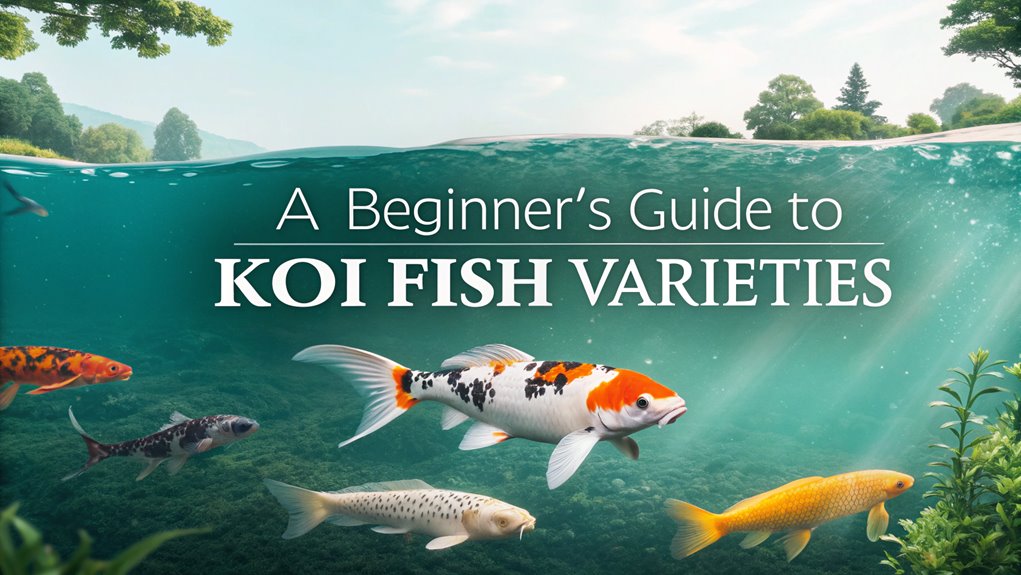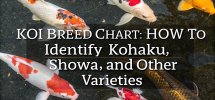To start with koi fish varieties, focus on Kohaku, Sanke, and Showa, which offer vibrant colors and distinct patterns. Kohaku stands out with a white base and vivid red spots, while Sanke adds black overlays. Showa features a black body with red and white highlights. These beginner-friendly varieties thrive in well-maintained ponds. Their distinct colors symbolize traits like love and purity. There’s much more to discover about these enchanting creatures.
TLDR
- Kohaku is a popular starter variety with a white body and red markings.
- Taisho Sanke features a white body with red and black patterns.
- Showa Sanshoku has a black base with red and white markings.
- Ogon varieties are known for their metallic gold and platinum hues.
- Butterfly Koi have elegant, flowing fins and come in various colors.
Understanding Koi Fish: A Brief Overview
Koi fish, or Nishikigoi, are the ornamental descendants of carp, meticulously bred over two centuries in Japan for their striking colors and intricate patterns.
You’ll find that koi come in over 100 variations, with 24 recognized classifications. Common varieties like Kohaku, Sanke, and Showa stand out with their unique color patterns and characteristics. The selective breeding for these vibrant ornamental fish guarantees a wide array of colors and patterns, making each koi a living tapestry.
Maintaining koi requires attention to water quality and providing high-quality pellets for nutrition.
A pond of at least 1,000 gallons is essential to accommodate their growth, as koi can reach impressive sizes under ideal conditions. Their care reflects a balance of aesthetics and precise environmental requirements.
The History and Evolution of Koi Varieties
Although koi keeping originated as early as 200 BC in Japan with the breeding of Magoi carp for food, it wasn’t until the late 19th century that these fish evolved into the ornamental pets we recognize today.
The evolution of koi varieties began in earnest with the Asagi, marking the inception of selective breeding for aesthetic appeal. This shift distinguished ornamental pets from mere food carp, catalyzing the creation of numerous recognized varieties.
Breeders, keen on enhancing beauty, embraced “Nishikigoi,” meaning “swimming jewel,” to capture their cultural significance. Through deliberate mutations, they’ve crafted over 100 variations, with 24 true classifications acknowledged in modern koi history.
This evolution highlights the intricate journey from practical breeding to the artistry of koi cultivation.
Popular Koi Varieties for Beginners
Having explored the intricate evolution of koi from food carp to ornamental treasures, let’s focus on koi varieties perfect for beginners.
These popular varieties aren’t just visually stunning but also easy to care for, making them ideal for novices.
- Kohaku: With its solid white body and striking red patterns, Kohaku is an iconic choice, offering simplicity and elegance.
- Taisho Sanke (Sanke): Known for its white body adorned with red and black markings, this variety symbolizes balance and prosperity.
- Showa Sanshoku: This variety features a black body with dynamic red and white markings, providing a strong visual impact.
- Ogon: Available in metallic gold and platinum, these koi add a brilliant sheen to your pond.
Consider Butterfly Koi for their graceful, flowing fins and diverse color options.
Exploring Unique Koi Patterns and Markings
How do koi enthusiasts distinguish between the myriad of unique patterns and markings that define each variety?
Understanding koi varieties requires attention to their unique patterns and colorations. The Kohaku is known for its pristine white base and distinct red markings.
In contrast, the Hi Utsuri showcases a black body with vivid red patterns, emphasizing bold color contrasts.
The Showa Sanshoku, with its black body adorned with red and white markings, demands precise color definition for quality assessment.
The Tancho Kohaku captivates with a singular red spot on a white base, offering simplicity.
Goshiki koi feature a white base with blue and black edging, enhanced by red and blue patterns.
These intricate markings and patterns are key in identifying and appreciating koi varieties.
The Significance of Koi Colors and Symbolism
Koi colors and their symbolism are deeply interwoven with cultural significance, particularly in Japanese and Chinese traditions.
These koi fish colors and patterns aren’t arbitrary; they embody profound meanings:
- Red: Represents love and courage, essential virtues in Japanese culture.
- White: Symbolizes purity and innocence, reflecting its emotional significance.
- Black: Often linked with overcoming adversity and achieving success, especially in Chinese culture.
- Kohaku (Red and White): Signifies purity of heart, making it a revered variety.
Different koi varieties carry specific meanings.
For instance, Matsuba, with its metallic sheen and black netting, signifies unique beauty.
The presence of koi in gardens and ponds isn’t just aesthetic; it symbolizes prosperity and harmony, aligning with the cultural significance of these vibrant creatures.
Tips for Selecting the Right Koi for Your Pond
When selecting koi for your pond, why not consider the specific needs and characteristics of these vibrant fish?
Begin by evaluating your pond conditions, guaranteeing it provides at least 1,000 gallons of space for growth, accommodating koi that may reach 36 inches.
Explore koi varieties like Kohaku, Sanke, and Showa, appraising their compatibility and feeding habits to maintain a harmonious aquatic environment.
Prioritize healthy koi with bright colors, clear eyes, and smooth scales, as these attributes indicate liveliness.
Examine markings and patterns meticulously, as distinct and well-defined features enhance visual appeal and value.
Finally, confirm your water conditions meet the requirements of your selected koi, fostering an ideal habitat for these enchanting creatures.
Caring for Koi: Essential Pond Setup and Maintenance
Before diving into koi pond maintenance, confirm your setup meets fundamental specifications for the health of these ornamental fish. Your koi pond should have a minimum volume of 1,000 gallons, providing ample space for growth and comfort.
Guarantee a depth of 3-4 feet to maintain stable water temperatures. Maintaining pristine water quality is essential, with pH levels between 6.8 and 8.4. Integrate a robust filtration system to keep water clean and oxygenated.
Regular monitoring is critical:
- Ammonia and nitrite levels: 0 ppm
- Nitrates: Below 40 ppm
- Temperature: Maintain 60-75°F
- Feeding practices: Adjust seasonally
These parameters support the health of your hardy fish, confirming a conducive environment through precise maintenance techniques.
Seasonal Care for Koi Fish: What to Expect
As you navigate the changing seasons, understanding koi fish care is essential to maintaining their health and vibrancy. In spring, increase feeding as water temperatures rise above 10°C with high-protein diets to support growth post-winter. Summer demands vigilant water quality monitoring; warmer temperatures can decrease oxygen levels and boost algae growth. During autumn, shift to wheat germ-based koi food as temperatures drop, prepping koi for winter. Winter care involves monitoring water temperature closely; koi become less active and might stop eating below 10°C. Make certain pond depths prevent freezing. Seasonal changes affect koi behavior, such as spring spawning and winter depth-seeking.
| Season | Feeding Type | Key Activity |
|---|---|---|
| Spring | High-protein diets | Spawning |
| Summer | Regular monitoring | Oxygen level management |
| Autumn | Wheat germ-based | Shifting for winter |
| Winter | Minimal or no feeding | Depth-seeking for warmth |
| Year-Round | Observe behaviors | Adjust care accordingly |
Common Challenges and Solutions in Koi Keeping
While keeping koi fish, you’ll inevitably encounter several common challenges that require prompt solutions to guarantee their well-being.
Maintaining ideal water quality is paramount. Elevated levels of ammonia and nitrites cause stress and health issues in various koi varieties. Optimal parameters include ammonia and nitrites at 0 ppm and nitrates below 40 ppm. Regular testing of pH levels, which should range from 6.8 to 8.4, is essential to prevent fluctuations that could harm koi.
- Feeding: Overfeeding leads to poor water quality; monitor protein content (30-40%) for young koi.
- Stress Indicators: Look for clamped fins or rapid gill movement due to water quality issues.
- Seasonal Changes: Adjust care, such as halting feeding below 10°C.
- Health Issues: Immediate intervention is necessary upon detecting stress signs.
Frequently Asked Questions
What Is the Best Koi for Beginners?
You should consider Kohaku for its simple two-color pattern, Sanke for its tricolor elegance, or Chagoi for its amiability and growth. Each provides distinct visual appeal and manageable care, perfect for novice koi enthusiasts.
What Is the Friendliest Koi Breed?
You’d think the friendliest koi breed would be elusive, but it’s the Chagoi. Their amiable temperament, enhanced by their tea-colored dermal chromatophores, makes them sociable, fostering human interaction. They display remarkable thigmotactic behavior, ensuring a rewarding experience.
What Is the Difference Between Kumonryu and Kikokuryu?
Kumonryu displays a scaleless body with dynamic black and white patterns, resembling dragons. Kikokuryu, however, boasts a metallic sheen with brilliant gold or silver hues. Both belong to the Utsuri group but exhibit distinct coloration and appearance.
What Is the Prettiest Type of Koi?
Imagine a living masterpiece gliding through water; many consider the Kohaku the prettiest koi. Its brilliant red patterns on a pure white canvas captivate, embodying a balance of simplicity and elegance that steals your breath away.
Conclusion
As you immerse yourself in the world of koi keeping, remember that selecting and caring for koi is like crafting a masterpiece; each choice shapes your aquatic canvas. By understanding the nuances of koi varieties, from their vibrant colors to intricate patterns, you’ll create a pond that’s both beautiful and harmonious. Make certain your pond’s environment meets their needs, and you’ll find joy in their graceful swim, turning your backyard into a living gallery of aquatic art.

